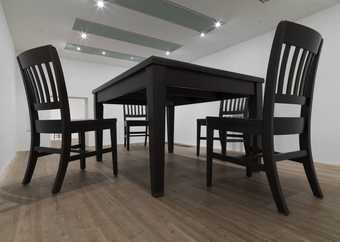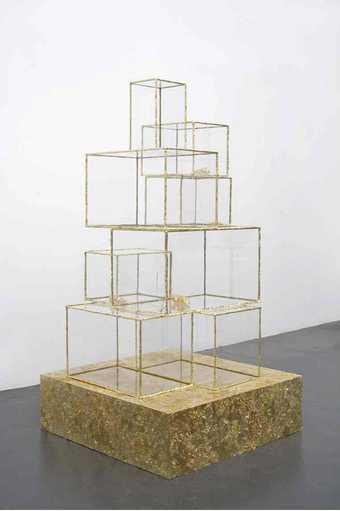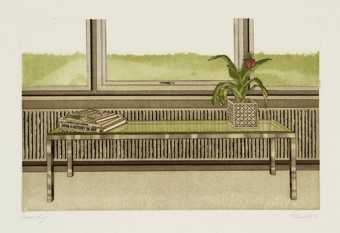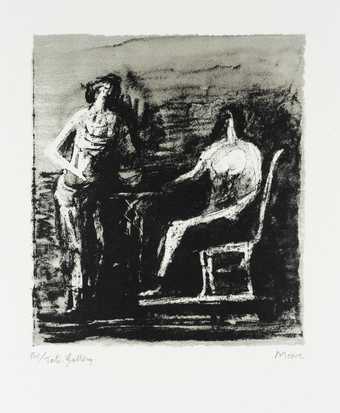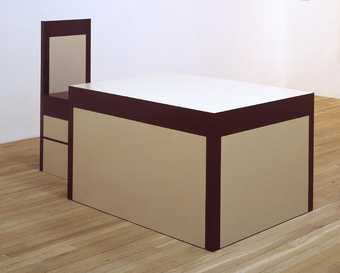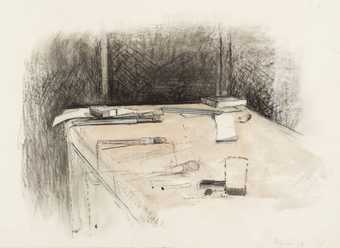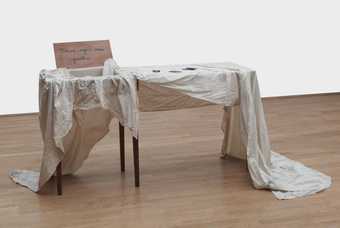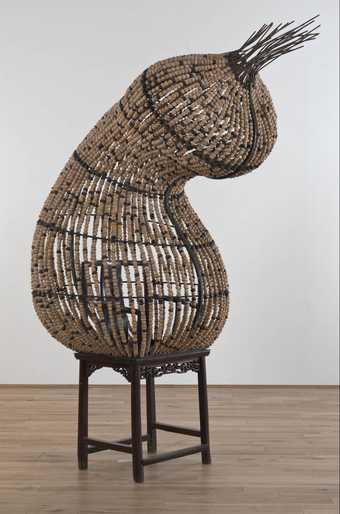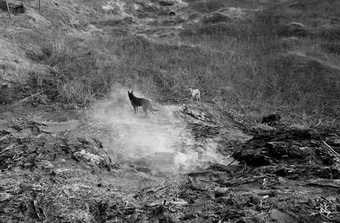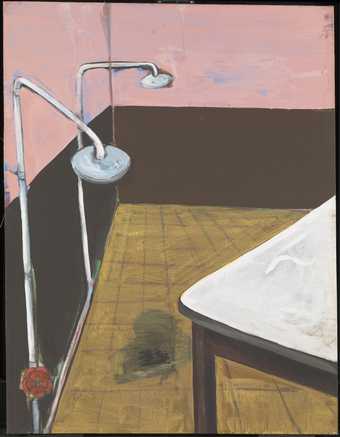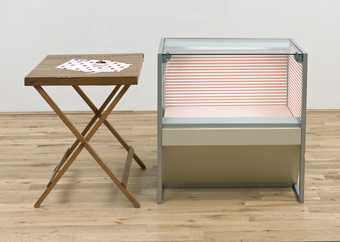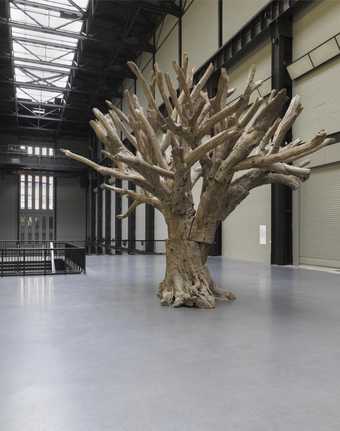
Not on display
- Artist
- Ai Weiwei born 1957
- Medium
- Wood
- Dimensions
- Unconfirmed: 4600 × 900 × 900
- Collection
- Tate
- Acquisition
- Purchased with funds provided by the Asia-Pacific Acquisitions Committee 2008
- Reference
- T12809
Summary
This work is a large sculpture comprising a square-topped wooden table with four legs, which has a very tall, cylindrical wooden pillar embedded into it vertically near to one corner. Although tightly wedged into a round hole cut in the surface of the table, the side of the pillar juts out slightly from the table’s edge. A heavy block of metal is attached to the inside of the bottom of the pillar and acts as a weight, holding it in place. Several large, rectangular holes of different sizes are cut into its top half. The lower part of the cylinder is loosely coated with red paint that has been scratched off in several areas, and its upper half combines bare sections of wood with patches that are thinly covered with an ash-grey coloured paint. The table is dark brown in hue but there are many scratches across its surface that reveal lighter tones of brown underneath. Despite its dilapidated look, the table’s thin legs, flat top and fluted edges suggest that it was once an elegant domestic object, and it appears especially delicate in comparison with the extremely heavy-looking, roughly hewn pillar.
Table and Pillar was conceived by the Chinese artist Ai Weiwei in 2002 and constructed by his studio assistants that same year. Both of its main components are found objects that were initially created sometime during the rule of the Qing dynasty in China (1644–1912). The pillar is made from an extremely hard, heavy wood called tieli and was formed from a partially hollowed-out tree trunk. It was originally part of a temple in southern China that had been subsequently dismantled, and Ai bought it from a furniture dealer who was selling fragments of the temple to carpenters for use in making new objects. Ai’s assistants disassembled the table completely in order to reconstruct it around the pillar: they separated the legs, struts and tabletop from each other, then cut a hole in the tabletop and inserted the pillar into it before re-attaching it to the legs and fitting all of the other parts back together. Shallow recessions can be seen in the side of the pillar where it protrudes slightly from the hole in the table, suggesting that Ai’s assistants cut grooves into its surface in order to avoid any evidence of a gap between the two objects. As is conventional in the construction of Qing dynasty furniture, this whole process was undertaken without the use of nails or an adhesive to hold the parts together and the sculpture can be disassembled piece by piece.
Table and Pillar is one of an extensive group of works that Ai made between 1997 and 2002 by dismantling pieces of Qing and Ming period furniture and re-assembling them in ways that make them difficult or impossible to use. The traditional procedures that Ai employed in constructing these works were very time-consuming, and he explained in 2009 that he is interested in the contradiction involved in spending ‘a tremendous effort … on something useless’ (Ai in Hans Ulrich Obrist, Ai Weiwei Speaks, London 2011, p.64). He has also noted that this method of constructing furniture without using glue or nails is no longer common because ‘it goes against industrial processes’ (Ai in Charles Merewether, ‘Changing Perspective: Ai Weiwei with Charles Merewether’, in Kunsthalle Bern 2003, p.34). Consequently, it could be argued that Table and Pillar and other works from this group question the drive towards efficiency and productivity that has dominated the industrialisation of contemporary China.
Ai has stated that he first began to work with traditional Chinese furniture because it offered a way of investigating the history of his home country (Karen Smith, ‘Giant Provocateur’, in Smith, Obrist, Fibichier and others 2009, p.82). However, rather than presenting historical objects unchanged, he always dismantles them and rearranges them into new forms. Ai has connected this to the way in which objects shed their original meanings and accrue new ones when they are removed from their initial contexts, stating that ‘you know an old temple was beautiful and beautifully built. We could once all believe and hope in it. But once it has been destroyed, it’s nothing. It becomes another artist’s material to build something completely contradictory to what it was before’ (Ai in Hans Ulrich Obrist, ‘Hans Ulrich Obrist in Conversation with Ai Weiwei’, in Smith, Obrist, Fibichier and others 2009, p.39).
Further reading
Ai Weiwei: Works: 1993–2003, exhibition catalogue, Kunsthalle Bern, Bern 2003, reproduced pp.40, 56, 122, 124.
Karen Smith, Hans Ulrich Obrist, Bernard Fibichier and others, Ai Weiwei, London 2009.
David Hodge
November 2014
Supported by Christie’s.
Does this text contain inaccurate information or language that you feel we should improve or change? We would like to hear from you.
Explore
You might like
-
Robert Therrien No Title (Table and Four Chairs)
2003 -
Terence Koh Untitled (A New World Order Lies in this Golden Age)
2006 -
Graham Greenfield Glass Table
1974 -
Henry Moore OM, CH Two Figures at a Table
1975 -
Richard Artschwager Table and Chair
1963–4 -
Rodrigo Moynihan Objects on a Table
1973 -
Marepe Deposit your lice here
1999 -
Chen Zhen Cocon du Vide
2000 -
Yang Fudong East of Que Village
2007 -
Ai Weiwei Sunflower Seeds
2010 -
Sabine Moritz Shower with Table
1993 -
Cathy Wilkes Stag and Mister Komplex
2000 -
Ai Weiwei Tree
2010

